Centralized system water supply in small summer cottages- great luxury. That is why, sooner or later, the problem of organizing water supply falls on the shoulders of their owners.
With a limited budget, the most rational way to solve the problem is to drill a well and install a hand pump. We will understand all the intricacies of the operation of such equipment, as well as its manufacture with our own hands.
1 Operational features of hand pumps
A water hand pump for a well is special device for pumping liquid to a surface under pressure. Equipment of this type is activated by human efforts by pressing a special lever mechanism.
Exploitation manual settings requires application physical strength, therefore it is rational to use them in areas with low water demand.
Of course, the operating speed and volumes of liquid lifted by the pump are incomparable with automatic systems, but lack uninterruptible source electricity is forcing summer residents to increasingly implement this particular format of devices.
1.1 Advantages and disadvantages
The manual method of raising water from a well has a number of advantages and disadvantages. The positive points include:
- The simplicity of the equipment was the reason for its quick installation.
- Installation of the system is possible in almost any conditions.
- Saving resources - the pump is driven by human effort, without requiring connection to the electrical network.
- The device consists of standardized units and parts that can be replaced if necessary - this feature allows you to maximize the service life of the installation.
- Hand pump costs much less than its analogues.
- You save money on putting equipment into operation, because the process is so simple that it does not require the involvement of a specialist.

1.2 Classification of hand pumps
Pumps for pumping water from an Abyssinian or other well perform the same function, but their design and principle of operation are somewhat different. Depending on the specified criteria, equipment with manual mechanism classified into two categories:
- piston pumps;
- sucker rod pumps.
Manual piston pumps are used in cases where the water in the area is located at a shallow depth - up to 10 m.
The operating principle of the equipment is quite simple. The device is a metal cylinder with a piston inside. Under the influence of physical force, it alternately moves down and up. Raising the lever by a person leads to the displacement of liquid through the inlet, and lowering it leads to the filling of the space above the piston with water.
It’s not difficult to build such a simple device with your own hands and install it on your summer cottage.
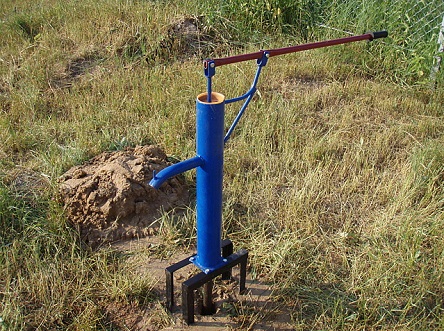
A deep manual rod pump is a more complex mechanism that is designed to pump water from an Abyssinian well or any other depth of 10-30 m. Its design consists of a cylinder, a piston and a very long rod, which, under the action of a lever, starts the entire system. The rod pump is located directly in the well, and its rod is immersed in the water layer to a depth of about 1 m.
To figure out which type of product is suitable directly for your operating conditions, you will have to study the basic criteria for choosing equipment.
2 Selecting a hand pump
The choice of hand pump for pumping liquid will depend on a number of factors:
- Well depth.
The most important criterion when purchasing equipment or making it yourself. To lift water from a shallow depth (up to 10 m) you can use simple mechanisms with piston system. If you have to pump liquid from an Abyssinian well with a depth of 10-30 m, you will have to choose a device with a rod system.
- Well diameter.
- Installation method.
When selecting a device, you need to think in advance whether there is a need for its further movement to another facility. This need often arises when liquid is taken from a river for household needs, and from a well for drinking.
- Period of use.
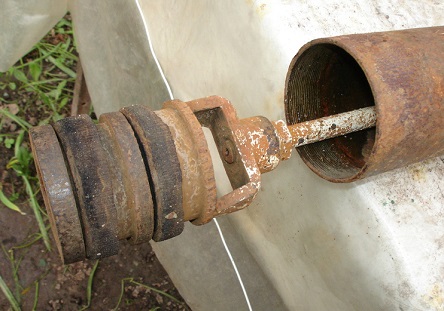
The main element of a hand pump is a piston in a pipe
There are models on sale designed for year-round use, as well as inexpensive options with a plastic body for use in the summer.
By considering every detail in advance, you can be sure that a hand pump for pumping water will meet the user's expectations.
2.1 Stages of manufacturing and connecting a hand pump
Assembling a hand pump with your own hands from available materials is a feasible task for every man. The main thing is to strictly follow these instructions:
- We make the body.
For body homemade pump you will need a metal cylinder - this could be a piece old pipe or an unnecessary liner from a diesel engine. The length of the segment should be about 60-80 cm, and the diameter should be over 8 cm.
To ensure high-quality operation of future equipment, it is necessary to sharpen inner surface pipes on the machine. By making the metal uneven, you will reduce the effort required to pump water.
- Cut out the lid.
To make it, you can use metal or plastic. Be sure to make a hole in the lid for the rod. When the structure is ready, a piston is placed inside. After this, the bottom is closed with exactly the same lid with a valve. A water supply pipe is welded to the side.
- Piston installation.
The piston can be made of wood, plastic or metal, the main rule is that it must be sealed with a rubber ring. When installing this structural element it is necessary to leave a minimum gap between the walls of the housing, then water will not leak out.
- Connecting the inlet pipe to the well.
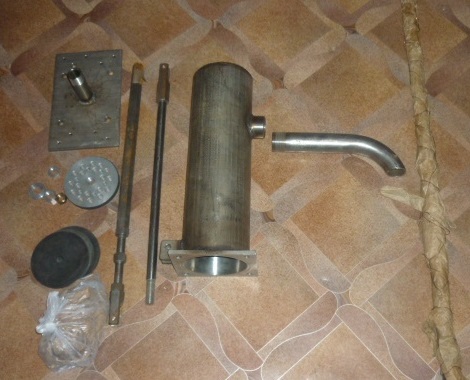
The inlet pipe supplying water inside the device must be strong and durable. To ensure these characteristics, select reinforced hoses that are rigid plastic elements or steel pipes.
- Installation of valves.
Check valves are special holes that are created in the piston body and the bottom cover of the metal cylinder. They determine the performance of the entire system. Valves prevent liquid from returning back into the incoming pipe.
To create them, you can use thick rubber, which is fixed to the hole using rivets.
- Decorative works.
A homemade hand pump should have a comfortable handle. Its shape can be any, the main thing is to securely attach the element to the rod. In addition, the pump itself must be fixed on the prepared site using a flange.
By carrying out the entire range of work described above, you will ensure uninterrupted water supply in your own area.
2.2 Stages of creating a pump (video)
Even today, in the immediate vicinity of cities, there are places where electricity has not yet arrived, or where it is supplied with frequent interruptions and sudden outages. However, many people choose them for permanent residence or countryside holiday due to the lower cost of plots or the desire for privacy. But they also need drinking water, which, in the absence of electricity supply, can be obtained using a water hand pump for a well.
Feasibility and advantages of use
It is impossible to live outside the city without water, even if you bring drinking water with you. It is necessary to water green spaces, clean the house, wash, wash, etc. If there are no natural sources nearby, you can get water from a well (see) or a borehole. But if in the first case you can get it with a bucket and a rope, then what about in the second?
The simplest and most reliable solution is to install a manual well pump that does not operate on electrical energy, but on the muscular strength of a person. This method of raising water as a backup is often used in places where the power supply is quite good in case of a power outage or accident.

Advantages of a hand pump
In addition to the fact that such a pump is capable of providing you with water in the absence of electricity, it has many more positive characteristics:
- Simple design, allowing you to operate the device in any conditions;
- Easy installation method, the ability to carry it out with your own hands without the involvement of equipment and specialists;
- Reliability and availability for repairs: any faulty components and parts of the unit can be easily found on sale or made independently and replaced;
- Economical: no need to pay for the electricity consumed by the pump;
- Low price– all models of hand pumps are much cheaper than their electric or gasoline counterparts;
- Possibility of installation in public places.
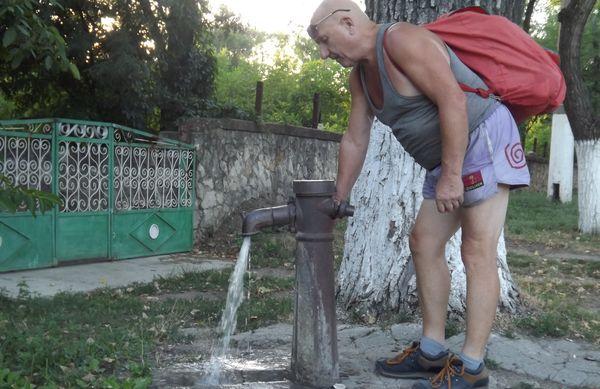
Flaws
Unfortunately, such equipment is not capable of lifting water from great depths, so hand pumps are used for, that is, relatively shallow, up to 16 meters.
Other disadvantages include low productivity, which is seriously inferior to the capabilities of automatic units, and the need to use physical force to obtain water, which can be difficult for the elderly and people with disabilities.
Design and principle of operation
Depending on the design, hand pumps for wells are divided into pump and vane pumps. They all work on the vacuum principle.
Pump pumps
Units of this type, in turn, are divided into piston and rod. They have a similar design, but the first are intended only for wells up to 7 meters deep, and the second are capable of supplying water from great depths.
- A piston pump pump is a metal cylinder 6 with a piston 7 inside, connected to a suction pipe 2 lowered into the well. A rubber valve 5 is installed at the bottom of the cylindrical body, which opens when the piston moves upward, letting water into the space underneath (see diagram). It rushes into the area of rarefied pressure created by the movement of the piston. At the same time, valve 8 in the piston itself closes, and the water above it pours into reservoir 10 and the outlet pipe of the device. When the piston connected by rod 9 to lever 11 goes down, valve 5 closes and valve 8 opens, again letting in the collected water into the space above the piston.
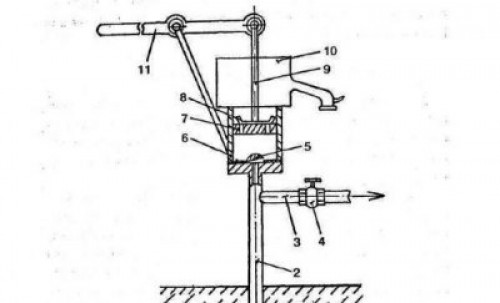
- Unlike a piston pump, a rod hand pump for a water well is installed directly in it. Cylinder 1 with valve 10 is attached to the end of suction pipe 2. Piston 8 with inlet valve 9 is attached to a long rod 3 and lowered into the cylinder. The rod in the upper part is connected to a rod 6, passing through the gland 5 and connected to the lever 7. The suction pipe is fixed to the well casing using a clamp 4. The operating principle of the device is similar to the previous one, but thanks to the long rod it allows you to lift water from great depths.
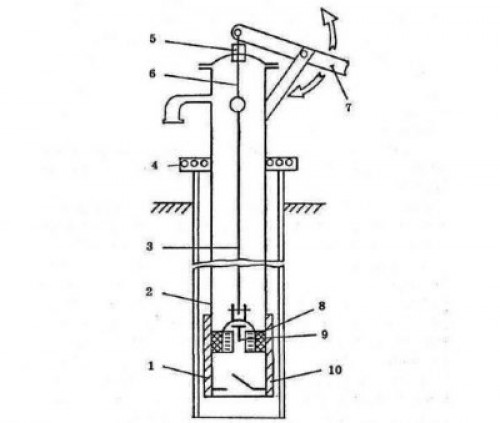
It is important. The normal operation of such pumps depends on how tightly the check valve at the suction port closes. If it starts leaking air, performance drops.
Both devices are operated by a lever-handle that moves up and down. Therefore, people often call them rocking chairs.
Vane pumps
Devices of this type consist of a housing with a cover, in which a wing with four valves at the outlet rotates on a shaft. As it moves, it alternately sucks in and then displaces water into the pressure pipe or outlet.
For reference. Unlike pop-up pumps, the handle of these devices does not move forward, but in a circular motion. The water supply is continuous during its movement.
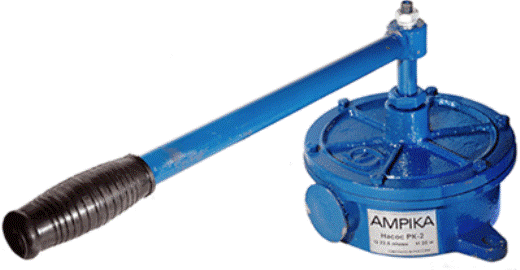
Due to more complex design Such devices are rarely used in everyday life; piston and rod pumps are more popular.
How to make your own hand pump
As can already be seen from the above diagrams, this is not a difficult matter. To do this, you don’t even need to specifically buy any parts and components; you can make everything yourself or use materials available on the farm.
So:
- The body can be made from a piece of pipe of a suitable diameter (duralumin or stainless steel), welding to it a bottom with a hole for a check valve. Even better is to use a liner from a diesel engine or a hydraulic cylinder body.
- The piston is also made of metal, but if you want, it can be made of plastic or even wood. And so that it fits well to the walls of the case, a rubber ring is put on it.

- The check and suction valves are cut out of thick rubber and fixed above the holes with a bolt and nut or rivet.
- It is advisable to make the piston rod and lever handle from light alloys in order to reduce the physical effort when pumping water with a hand pump.
After assembly, the pump is connected to a suction pipe, which is lowered into the well. The instructions recommend using a pipe rather than a hose, as it will compress when pressure changes inside and interfere with the operation of the device.
Installation of the unit, regardless of whether you bought a ready-made pump or made it yourself, should be done on a flat, hard platform.
Conclusion
If you decide that making a hand pump for wells is within your capabilities, we recommend that you take a look interesting video in this article, which talks about all the nuances of the process. We are sure you will succeed. Just do not forget to inspect the device from time to time, lubricating the parts and monitoring the condition of the valves.
The manufacture of such a design as a hand pump for a well or a well worries many owners of country cottages or summer cottages.
Commercially available equipment of this type discourages the buyer with a rather high price and operates mainly on electricity, which is not always convenient when using water periodically. Required design selected depending on the depth of the well. Therefore, many craftsmen make a pump for a well with their own hands. Homemade samples of such equipment will be described below.
Construction of a homemade piston pump for wells

Figure 1. Diagram of a piston pump.
Pumping water through such a unit is carried out using a piston, which is mounted on a rod and moves freely up and down the metal body of the pump. Check valves are installed inside this piston to prevent fluid from returning to the well. The rod is attached by a hinge to the lever handle. When you press it, the well pump is activated. An inlet hose is connected to the lower part of the device body, the free end of which is lowered into the well to the aquifer. An outlet pipe is welded on the other side of the body: it is located approximately in the middle of the unit.
Such a pump can be used with a well depth of no more than 10 m. It is installed at a distance of 80-100 cm from the ground. To increase the efficiency of such a unit, you can additionally install an inexpensive purchased electric pump, which should have a separate output. The suction hose must be deepened into the groundwater by 5-7 cm. This allows for uninterrupted operation of the device. To supply water to the consumer, a shut-off valve and a pipe system made of metal or plastic are usually used. If you equip this water lift with an additional filter, you can use the liquid not only for watering the area, but also for cooking and other needs.
Manufacturing of piston and hand pumps
In order to make a similar unit for a well in the country from scrap materials, you can use the following technology:

Figure 2. Diagram of a piston pump.
- First you need to select a housing for the pump. A metal pipe is used for this. required length. If possible, you can use a diesel sleeve or a hydraulic cylinder housing. The length of the pipe can be about 600-800 mm with a caliber of at least 8 cm. The best thing is to make a body from a thick-walled tube on lathe. In this case, the inner walls of the pump are smooth. If you use a metal piece, you need to remove all internal irregularities with a scraper. The body does not have to be round: it can be square or polygonal. The main condition is that it must have the same cross-section along its entire length. The pump piston has the same shape as inner part devices.
- Covers for the unit can be made of metal or thick plastic. Wood can also be used. Oak or larch are good for this. This material swells with water and seals well the gaps between the walls of the hand pump. IN top cover They make a hole for the rod, and connect the bottom one to the valve and put it in place. A hole is made in the side of the housing and the outlet pipe is welded.
- The piston is made from any suitable material: metal, plastic or wood. The main condition is that it must have a rubber seal, which is usually made in the form of a ring. The piston should move inside the well pump housing easily, without tension. It is connected to the stem using a thread and a locking pin.
- As an inlet pipe, you can use hard rubber hoses reinforced with a metal spring. Often plastic or metal pipes are used for this part.
- The most important detail hand pump for a well - these are check valves. The performance of the entire device depends on their quality. They must have enough robust construction to prevent water from returning to the inlet hose. The greatest attention must be paid to the grinding of the pump valves, otherwise the liquid will seep through them and return back to the well or well. Diaphragm or ball check valves are suitable for a hand pump. The first type can be made from a durable piece of rubber. It is secured to the valve inlet using rivets or screws and nuts. When using a ball lock, it is made of metal or plastic. Some craftsmen use round valves made of hard rubber or glass for hand pumps.
- The outlet pipe and rod are selected to such a length that the unit can be buried 0.5-1 m into the well. You will also need a hinged handle, which must be attached to the rod (it is made of an aluminum or duralumin tube). To do this, a hole is drilled in the outlet part of the lifting rod and a bolt is inserted, which is passed through the handle and secured on the other side with a nut with a locking pin. To independently return the handle to its original position, a spring is attached to its short end, the lower part of which is secured to the body with a screw.
A similar design of a hand pump for a well is used in many summer cottages and shows itself to be quite reliable in operation (Fig. 1).
Water pump as another type of hand pump for wells
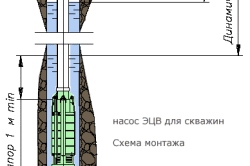
Figure 3. Diagram of a deep-well pump.
To create such a structure, you need to buy copper tubes and epoxy glue from the construction market. Take out the old brake chamber (you can also use a new one, but then you will have to purchase it) and, having disassembled it, plug all the holes, except for one: it is intended for the rod (located in the upper part of the future pump). At the opposite end of the brake chamber (bottom), several holes for the valves are drilled. Then they take a piece of purchased copper tube (it should have thick walls) and select a steel ball with a diameter that is slightly larger than its caliber. The tube must be drilled half its length with a drill. The hole should be smaller than the diameter of the ball. He is placed in copper tube(across the drilled hole) and solder a piece of copper wire on top. When the water rises, the ball will rise and open a passage for it, and with pressure from the upper side, the same ball will close the opening. Copper wire will not let it fall out of the tube.
Then they begin to manufacture a check valve, which is made by analogy with the inlet lock described above. The difference is that a spring must be placed between the wire and the ball. It is needed to press the ball to the hole. This part works under pressure from above and opens the hole.
The valves are inserted into place and secured with epoxy glue. Then they cut off a piece of the car inner tube and cut a circle out of it. A rubber membrane for the pump will be made from it, and its diameter should correspond to the size of the brake chamber. A hole is made in the middle of this circle and the washers are glued on both sides with epoxy glue.
For further work, you will need a metal pin with a thread, which must be inserted into the washers and tightened with nuts. The resulting membrane must be glued to the brake chamber from below. The rod is passed into the hole at the top of the device and the handle is soldered to it. The pump is ready for use (Fig. 2).
Such a unit has a higher productivity than a piston unit, but the reliability of its operation depends on the quality of the rubber from which the membrane is made.
How to make a simple deep-well pump with your own hands?
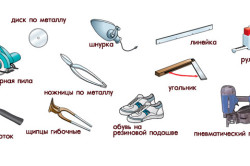
Such a unit is used when the well depth is more than 12 m. Its design resembles a piston type. To do this, you need to make a metal cylinder to collect water and purchase pipes and hoses through which it will move, a manual drive and a special piston block.
Intake metal pipes are installed at the level groundwater with a slight recess and brought to the surface. There they are strengthened with clamps, and a gasket is fixed to their upper part. A homemade cylinder, which is made on a lathe from thick-walled metal pipe, is lowered into the well so that the piston of the device does not reach the lower flap, which is made in the form of a disk. The distance between them should be 5-7 cm. The upper end of the rod is passed through the gasket and connected to manual drive. When this rod is raised and lowered, the flaps in the pipes must close and open, and the space above the piston must be filled with liquid. If water comes out, then this volume is filled with air, which contributes to the further rise of the liquid up the pipe (Fig. 3).
To manufacture a well pump, the following tools and materials are used:
- a piece of metal pipe;
- brake chamber;
- round timber made of plastic, wood (for piston pump covers and its piston);
- copper and duralumin tubes;
- tires and inner tube;
- metal balls and wire;
- material for check valves piston pump;
- hose made of durable rubber or plastic, metal or plastic pipes;
- gaskets;
- springs for the handle and rod for the pump rod;
- epoxy adhesive;
- welding machine;
- lathe;
- electric drill with drills;
- scraper;
- file, hammer, tape measure, ruler.
At self-production pump for a well, you must strictly adhere to the technology of its creation and install it correctly on site, and only then this unit, made with your own hands, will serve its owner for a long time and reliably.








